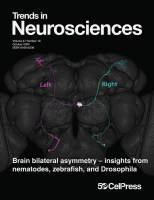Trends Neurosci. 2024 Sep 24:S0166-2236(24)00146-2. doi: 10.1016/j.tins.2024.08.003
Brain bilateral asymmetry – insights from nematodes, zebrafish, and Drosophila
François Lapraz1, Cloé Fixary-Schuster1, Stéphane Noselli1
Affiliations
1Université Côte d’Azur, CNRS, Inserm, iBV, Nice, France.
Abstract
Chirality is a fundamental trait of living organisms, encompassing the homochirality of biological molecules and the left-right (LR) asymmetry of visceral organs and the brain. The nervous system in bilaterian organisms displays a lateralized organization characterized by the presence of asymmetrical neuronal circuits and brain functions that are predominantly localized within one hemisphere. Although body asymmetry is relatively well understood, and exhibits robust phenotypic expression and regulation via conserved molecular mechanisms across phyla, current findings indicate that the asymmetry of the nervous system displays greater phenotypic, genetic, and evolutionary variability. In this review we explore the use of nematode, zebrafish, and Drosophila genetic models to investigate neuronal circuit asymmetry. We discuss recent discoveries in the context of body-brain concordance and highlight the distinct characteristics of nervous system asymmetry and its cognitive correlates.
DOI: 10.1016/j.tins.2024.08.003

